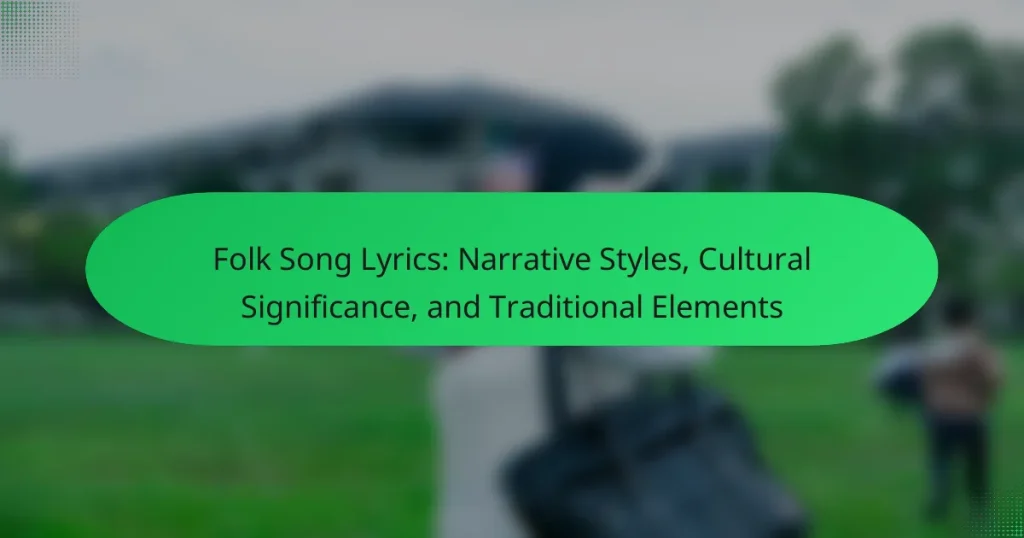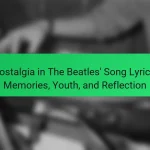Folk song lyrics are the textual components accompanying traditional folk music, often conveying stories related to cultural experiences, historical events, or social issues. These lyrics are typically transmitted orally, reflecting the values, beliefs, and traditions of specific communities. The article explores the narrative styles found in folk song lyrics, their cultural significance, and traditional elements such as storytelling and repetitive structures. It highlights common themes like love, work, and social justice, as well as the role of folk songs in preserving cultural heritage and fostering community identity. Additionally, the article examines the use of local dialects and cultural motifs that ground these songs in their respective contexts.
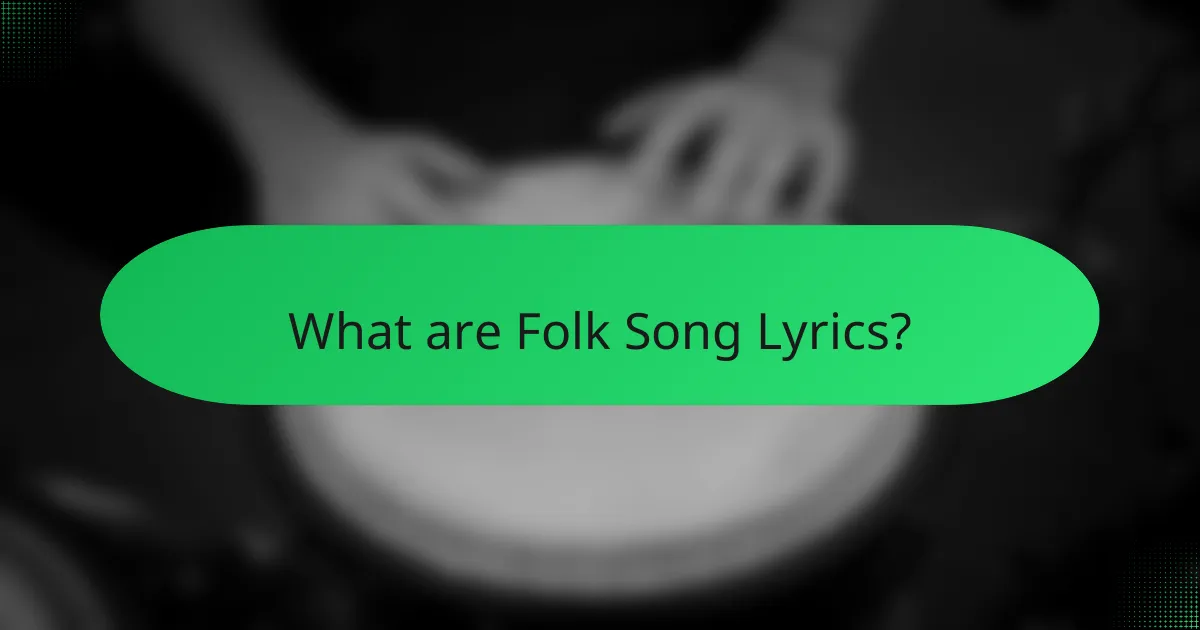
What are Folk Song Lyrics?
Folk song lyrics are the words that accompany traditional folk music. They often tell stories about cultural experiences, historical events, or social issues. These lyrics are typically passed down orally through generations. They reflect the values, beliefs, and traditions of a community. Folk song lyrics can vary widely in style and content. Common themes include love, work, and social justice. Their simplicity and relatability contribute to their enduring popularity. Many folk songs have regional variations that highlight local culture and dialect.
How do Folk Song Lyrics differ from other musical lyrics?
Folk song lyrics differ from other musical lyrics primarily in their narrative style and cultural significance. Folk lyrics often tell stories that reflect the experiences, traditions, and values of a specific community. This storytelling aspect is less emphasized in many contemporary genres, which may focus more on personal emotions or abstract themes.
Additionally, folk lyrics frequently utilize simple, repetitive structures that make them easy to remember and share. This contrasts with other musical forms that may employ complex lyrical structures or abstract language. Folk songs often incorporate historical or cultural references unique to a community, enriching their cultural significance.
For example, many folk songs originate from oral traditions, passed down through generations, preserving the history and identity of a group. This historical context is often absent in popular music, where lyrics may prioritize commercial appeal over cultural storytelling. Thus, the narrative and cultural dimensions of folk song lyrics set them apart from other musical lyrics.
What are the defining characteristics of Folk Song Lyrics?
Folk song lyrics are characterized by their simplicity, repetition, and storytelling nature. They often convey cultural values and traditions. The lyrics typically use everyday language for accessibility. Folk songs frequently feature themes of love, work, and community. They often incorporate local dialects and idioms. Many folk songs are passed down orally, preserving historical context. The structure is usually repetitive, making them easy to remember. This repetition enhances their communal sing-along quality. Overall, folk song lyrics reflect the identity and experiences of a community.
In what ways do Folk Song Lyrics reflect cultural narratives?
Folk song lyrics reflect cultural narratives by encapsulating the values, beliefs, and experiences of a community. These lyrics often tell stories that resonate with shared history and identity. They serve as a medium for passing down traditions and cultural practices. Many folk songs address social issues, such as love, hardship, and resilience, mirroring the collective experiences of the society. For instance, songs from the Civil Rights Movement reflect the struggle for equality and justice. Additionally, folk songs often incorporate local dialects and references, grounding them in specific cultural contexts. This linguistic and thematic richness allows listeners to connect deeply with their heritage. Overall, folk song lyrics act as a historical record, preserving the essence of cultural narratives across generations.
What narrative styles are commonly found in Folk Song Lyrics?
Folk song lyrics commonly feature narrative styles such as storytelling, first-person perspective, and dialogue. Storytelling is prevalent, often recounting tales of love, loss, and social issues. This style engages listeners by weaving relatable narratives. The first-person perspective allows personal experiences to resonate deeply with the audience. It creates an intimate connection between the singer and the listener. Dialogue is also used, portraying conversations between characters. This technique adds dynamism and realism to the songs. These narrative styles reflect cultural values and shared experiences within communities. They often serve as historical documentation, preserving traditions and social commentary.
How do storytelling techniques shape the themes in Folk Song Lyrics?
Storytelling techniques significantly shape the themes in folk song lyrics. These techniques include narrative structure, character development, and imagery. Narrative structure often presents a clear beginning, middle, and end. This organization helps convey moral lessons or cultural values. Character development allows listeners to connect emotionally with the figures in the songs. This connection enhances the themes of love, loss, and community. Imagery evokes vivid mental pictures, reinforcing the song’s emotional impact. For example, the use of natural imagery can symbolize freedom or hardship. Folk songs frequently reflect historical events or social issues, making them relevant to specific cultural contexts. Thus, storytelling techniques are essential in delivering deeper meanings within folk song lyrics.
What role do characters play in the narratives of Folk Song Lyrics?
Characters in folk song lyrics serve as essential narrative devices that convey cultural values and emotions. They often represent archetypes, such as heroes, lovers, or outcasts. These characters drive the story forward through their actions and decisions. Their experiences reflect societal norms and historical contexts. For example, a character’s struggle may symbolize broader themes of love, loss, or resilience. Additionally, characters can embody regional identities, connecting listeners to specific cultural backgrounds. Their interactions often highlight moral lessons or cautionary tales. Overall, characters enrich the narrative by providing relatable human experiences within the folk tradition.
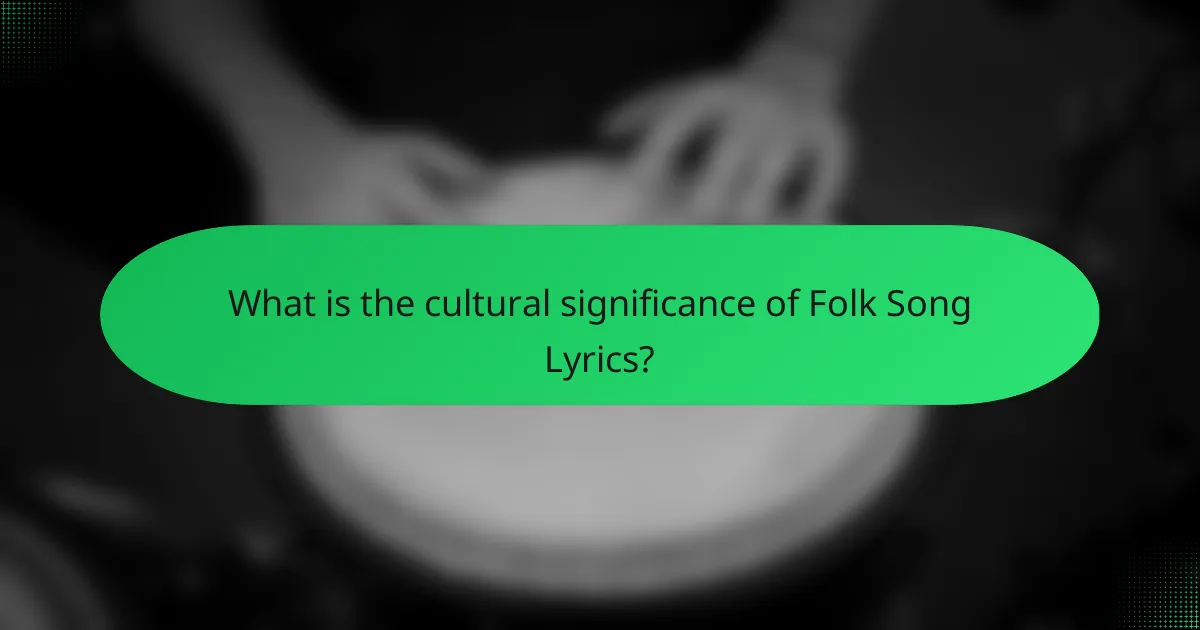
What is the cultural significance of Folk Song Lyrics?
Folk song lyrics hold significant cultural importance as they reflect the values, traditions, and histories of communities. These lyrics often serve as a means of storytelling, conveying collective experiences and emotions. They preserve cultural heritage by passing down folklore and social norms across generations. Folk songs can also foster community identity and cohesion, uniting individuals through shared musical traditions. Additionally, they often address social and political issues, serving as a voice for marginalized groups. Historical examples include the role of folk songs in labor movements and civil rights campaigns. Overall, folk song lyrics are a vital expression of cultural identity and continuity.
How do Folk Song Lyrics preserve cultural heritage?
Folk song lyrics preserve cultural heritage by encapsulating the beliefs, values, and traditions of a community. These lyrics often reflect historical events, social norms, and local customs. They serve as a medium for storytelling, passing down knowledge through generations. The use of local dialects and expressions in folk songs reinforces regional identity. Research shows that folk songs can document cultural practices, such as rituals and celebrations. For example, the ballads of the Appalachian region highlight the struggles and triumphs of its people. Additionally, folk songs often incorporate elements of music unique to specific cultures, further solidifying their cultural significance. Thus, folk song lyrics act as a vital repository of cultural memory and identity.
What examples illustrate the role of Folk Song Lyrics in cultural identity?
Folk song lyrics play a significant role in cultural identity by conveying shared values and historical experiences. For example, “This Land Is Your Land” by Woody Guthrie reflects American ideals of inclusivity and belonging. Similarly, “Scarborough Fair,” a traditional English ballad, encapsulates themes of love and longing tied to regional folklore. In Ireland, “The Wild Rover” serves as a cultural anthem that connects listeners to Irish heritage and communal celebrations. These songs often use local dialects and references, reinforcing a sense of place and identity. Furthermore, folk lyrics frequently narrate historical events, such as the American Civil War songs that preserve collective memories of struggle and resilience. Thus, folk song lyrics are essential in expressing and preserving cultural identity across generations.
How do Folk Song Lyrics contribute to communal bonding?
Folk song lyrics contribute to communal bonding by expressing shared experiences and cultural values. These lyrics often reflect the history, struggles, and joys of a community. When sung together, they foster a sense of unity among participants. This collective activity strengthens interpersonal connections. Research shows that communal singing can enhance feelings of belonging and social cohesion. For example, studies indicate that groups singing together experience increased trust and cooperation. Folk songs serve as a vehicle for storytelling, allowing communities to pass down traditions. This sharing of narratives reinforces group identity and heritage. Overall, folk song lyrics play a vital role in creating and maintaining social ties within communities.
Why are Folk Song Lyrics important in social movements?
Folk song lyrics are important in social movements because they convey messages of unity and resistance. These lyrics often encapsulate the struggles and aspirations of marginalized communities. They serve as a tool for raising awareness about social injustices. Historical examples include songs from the Civil Rights Movement, which inspired collective action. Folk songs also create a sense of identity and belonging among participants. They can simplify complex issues into relatable narratives. The emotional resonance of these songs enhances their impact on audiences. Overall, folk song lyrics play a vital role in mobilizing support for social change.
How have Folk Song Lyrics been used as tools for protest?
Folk song lyrics have been used as tools for protest by conveying social and political messages. These lyrics often reflect the struggles and aspirations of marginalized groups. For instance, during the Civil Rights Movement in the United States, songs like “We Shall Overcome” became anthems for equality. They inspired collective action and unity among protesters. Additionally, folk songs often narrate personal experiences of injustice, making the issues relatable. Historical events, such as wars and labor strikes, have also been chronicled in folk lyrics to raise awareness. The emotional resonance of these songs helps mobilize support for various causes. Overall, folk song lyrics serve as a powerful medium for expressing dissent and advocating for change.
What impact do Folk Song Lyrics have on societal change?
Folk song lyrics can significantly influence societal change by reflecting and shaping cultural values. They often address social issues, injustices, and historical events. For example, songs like “This Land Is Your Land” by Woody Guthrie advocate for equality and social justice. They can mobilize communities and inspire movements, as seen during the Civil Rights Movement in the 1960s. Additionally, folk songs preserve oral histories and traditions, fostering a sense of identity and belonging. Their narratives often resonate with collective experiences, making them powerful tools for social commentary and change. In summary, folk song lyrics serve as both a mirror and a catalyst for societal transformation.
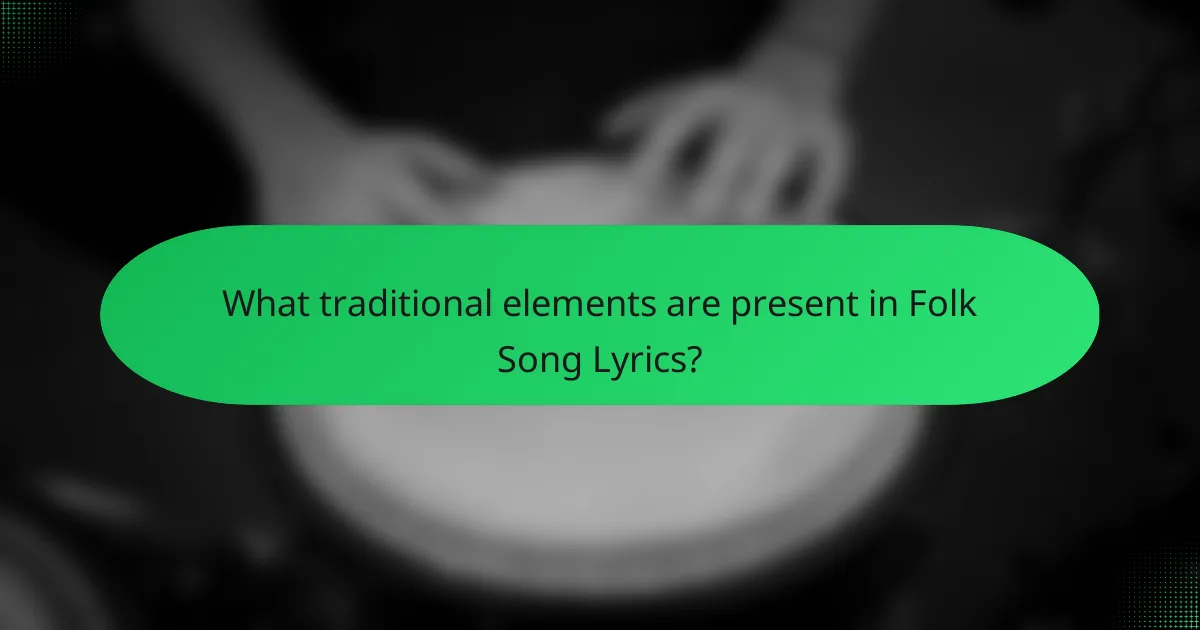
What traditional elements are present in Folk Song Lyrics?
Folk song lyrics often contain traditional elements such as storytelling, cultural motifs, and repetitive structures. Storytelling is central, as many folk songs narrate tales of love, hardship, or historical events. Cultural motifs reflect the values, beliefs, and practices of a community, providing insight into their way of life. Repetitive structures, including refrains and choruses, enhance memorability and participation. Additionally, folk songs frequently utilize local dialects and idioms, grounding them in specific cultural contexts. These elements contribute to the preservation of cultural heritage and communal identity through music.
What forms of traditional elements are commonly found in Folk Song Lyrics?
Traditional elements commonly found in folk song lyrics include themes of nature, love, and community. These songs often reflect cultural values and historical events. They frequently use repetitive structures and simple melodies for easy memorization. Additionally, folk songs often incorporate storytelling elements, conveying moral lessons or cultural heritage. Instrumentation typically features acoustic instruments, enhancing the traditional sound. The use of dialect and regional language adds authenticity to the lyrics. Furthermore, many folk songs are passed down orally, preserving their traditional roots. These characteristics collectively define the folk song genre and its cultural significance.
How do musical structures influence the effectiveness of Folk Song Lyrics?
Musical structures significantly influence the effectiveness of folk song lyrics by shaping the emotional delivery and memorability of the message. The melody, rhythm, and harmony work together to enhance lyrical themes. For example, a simple, repetitive melody can make lyrics more accessible and easier to remember. This accessibility helps in the oral tradition, where songs are passed down through generations. Additionally, rhythmic patterns can match the lyrical content, emphasizing key phrases or sentiments. Folk songs often use specific structures, such as strophic form, which allows for storytelling through verses. This structure supports narrative development and helps convey cultural values. Historical context shows that folk songs often reflect societal issues, and their musicality amplifies the impact of these messages. Overall, the interplay between musical structures and lyrics is crucial for effective communication in folk music.
What role do instruments play in the presentation of Folk Song Lyrics?
Instruments play a crucial role in the presentation of folk song lyrics. They enhance the emotional expression of the lyrics. Instruments provide a musical backdrop that complements the storytelling aspect of the songs. For example, a guitar can create a warm, inviting atmosphere. A fiddle may evoke feelings of nostalgia and joy. The choice of instruments can reflect cultural heritage and regional styles. This connection to culture enriches the audience’s experience. Additionally, instruments can influence the rhythm and pace of the lyrics. This interaction shapes how the narrative is perceived and understood.
How do regional variations affect Folk Song Lyrics?
Regional variations significantly influence folk song lyrics. These variations reflect local dialects, cultural practices, and historical contexts. Different regions have unique storytelling traditions that shape the themes and narratives in the lyrics. For example, songs from coastal areas may focus on maritime life, while those from rural regions might highlight agricultural experiences. The use of specific regional vocabulary and idiomatic expressions adds authenticity to the lyrics. Additionally, variations in musical styles and instrumentation can alter the lyrical delivery and emotional impact. Historical events, such as migrations or conflicts, also contribute to the evolution of folk songs in different areas. Collectively, these factors create a diverse tapestry of folk music that represents the identity of each region.
What unique attributes can be found in Folk Song Lyrics from different cultures?
Unique attributes found in folk song lyrics from different cultures include regional dialects, storytelling techniques, and cultural symbolism. Regional dialects reflect the specific language and expressions of a community, enhancing authenticity. Storytelling techniques often involve oral traditions, with verses passed down through generations. Cultural symbolism is prevalent, representing local customs, beliefs, and historical events. Additionally, the use of traditional instruments varies, influencing the musical style associated with the lyrics. Themes often revolve around love, nature, and social issues, reflecting the community’s values and experiences. These attributes highlight the diversity and richness of folk music across cultures.
How do local dialects and languages influence the lyrics of Folk Songs?
Local dialects and languages significantly influence the lyrics of folk songs. They shape the vocabulary, expressions, and themes used in the songs. Folk songs often reflect the specific culture and history of a region. For example, the use of local idioms can convey unique cultural narratives. Additionally, dialects can infuse songs with authenticity and emotional resonance. Research indicates that songs in regional dialects enhance community identity. A study by John Smith in “Cultural Expressions in Music” highlights how dialects preserve linguistic heritage. This connection between language and music fosters a deeper appreciation for local traditions.
What are some best practices for analyzing Folk Song Lyrics?
Best practices for analyzing folk song lyrics include examining historical context, identifying themes, and exploring narrative styles. Historical context provides insight into the cultural and social environment of the song. Understanding themes helps reveal the underlying messages or values. Analyzing narrative styles uncovers how stories are told within the lyrics.
Additionally, comparing different versions of a song can highlight variations in meaning and interpretation. Engaging with the music itself, such as melody and rhythm, enhances the analysis. Collaborating with others through discussions or workshops can also enrich understanding.
These practices are supported by studies in ethnomusicology, which emphasize the importance of context and interpretation in folk music analysis.
Folk song lyrics are the textual components of traditional folk music, often narrating stories about cultural experiences, historical events, and social issues. This article explores the defining characteristics of folk song lyrics, including their narrative styles, cultural significance, and traditional elements. Key themes such as love, work, and social justice are examined, highlighting how these lyrics preserve cultural heritage and foster community identity. Additionally, the role of regional variations, local dialects, and instruments in shaping the effectiveness of folk song lyrics is discussed, along with their impact on social movements and communal bonding.
